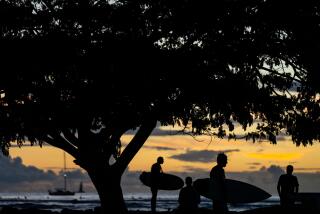Music to Her Ears : Musician’s Devotion Helps Inspire a Resurgence of the Folk Harp
- Share via
GLENDALE — Twenty-three years ago, a discordant experience redirected Sylvia Woods in her musical education and because of it, she’s been playing a happy harp ever since.
A student of piano and flute since the age of 6, Woods said she “absolutely hated” her piano teacher when she began music studies at the University of Redlands in 1969. So she switched to the harp.
Now, at 41, the La Crescenta resident, who won the All-Ireland Harp Championship in 1980, is considered one of the world’s foremost harpists and is credited with shaping a musical subculture around the dulcet-toned instrument’s smaller cousin, the folk harp.
“Sylvia Woods has practically single-handedly brought about an interest in folk harps in the last few years,” said Sylvia Fellows of Anaheim, secretary and membership chairman of the International Society of Folk Harpers and Craftsmen, a nonprofit, educational organization with more than 1,450 members.
Woods has toured internationally and has also built a following through a mail-order business she runs from her home. Over the last 14 years, she has established the world’s most extensive catalogue of harps, folk harps and music played on the harp, including her own recordings.
Now, Woods has opened her own retail outlet, the Sylvia Woods Harp Center at 915 N. Glendale Ave., which she says has “the largest harp inventory west of the Mississippi.”
Although some music stores in the Los Angeles area carry a harp or two, Woods has more than 40 in her inventory, ranging in price from a $600 lap-held model to elaborate orchestral harps with gold inlays that cost as much as $25,000. She also sells more than 100 harp cassettes and discs, plus books, accessories and gift items with a harp motif, such as T-shirts, coffee mugs and rubber stamps.
Her closest competitor, Woods said, is the showroom of Lyon & Healy in Chicago, a 103-year-old manufacturer of harps whose models she carries. She also stocks versions from the Italian manufacturer Salvi, as well as a variety of harps built by Dusty Strings of Seattle and Triplett of San Luis Obispo.
Her most popular items are the so-called folk harps. They are smaller and easier to play than the large orchestral harps, which have pedals, similar to a piano, used to hit flat and sharp notes. Folk harps have small levers on strings used to change tones. Some models are small enough to fit under an airplane seat.
All harps are painstakingly hand-carved from strips of wood glued together. They vary in price according to the type of wood used, the amount and type of carving and inlays, the composition and number of strings, and the number of levers.
Woods said harps are believed to date back more than 5,000 years, when ancient archers added strings to their bowed weapons and played them. The instrument has been shrouded with legends for centuries, conjuring images of cupid, romance and angels. The harp is the national instrument of Paraguay, Ireland and Wales.
“What could be more appropriate than the harp in the City of Angels?” said Tom Woods, Sylvia’s husband of 16 years and co-owner of the harp center in addition to running an underwater maintenance business in Marina del Rey.
Fellows, of the folk harpers’ society, said the group’s membership has swelled by more than 70% since 1985 as the number of harp craftsmen has increased. She said the largest population of folk harpers is on the Pacific coast, concentrated in Los Angeles. New York and Texas rank second and third.
“Southern California is particularly open to different ways of doing things, breaking traditional ways and searching out the old ways,” Fellows said.
Theresa Rossell of La Crescenta said she fulfilled a five-year dream last week when she came to the store to buy a folk harp for herself and her two older daughters, ages 14 and 11. She said she fell in love with the instrument when she listened to Woods play during the Montrose Arts and Crafts Festival and briefly took lessons until she became pregnant with her third daughter, now 18 months old.
Eleanor Rossell’s eyes danced as the 14-year-old listened to Woods tune, then play the family’s purchase.
“Do you like it?” Woods asked. “Oooh, yes!” sighed Eleanor, clutching at her heart.
“Music sets a mood, a tempo in the home when any member of the family is playing,” said Theresa Rossell, whose ancestry is Welsh. “The harp is so nice, you really can’t make a bad sound with it, even when practicing. It’s not like a trumpet or violin, which are not so forgiving.”
Another new customer, Jennie Hanna, is a 17-year-old Mission Viejo High School senior. She said she had longed for a harp since age 7 when her grandfather took her to a restaurant where a harpist was playing. “I never even touched my food. I just watched her play, it was so beautiful,” Jennie said. “I fell in love with that instrument and decided then that when I had the opportunity and enough money, I would buy a harp.”
The Orange County teen-ager--who plays piano and guitar and sings--said she worked as a swimming instructor at the high school for two years to earn money for a harp. She learned about the harp center earlier this month from an ad in a catalogue at a bookstore and immediately drove to Glendale with $600 in savings to make her purchase.
“When I walked in the door, I spotted this beautiful harp that I knew I just had to have, but it was $6,800,” Jennie said. “It bummed me out.” But, determined to have the best she could afford, Jennie pledged to spend almost all of her savings--$900--for a folk harp larger than she originally had intended to buy. “It isn’t real fancy, but it is made out of walnut and is sooo beautiful,” Jennie gushed. Her parents have agreed to pay for lessons. She hopes to learn to play the “Pachelbel Canon” on the harp in time for her friends’ wedding Nov. 27.
Woods’ prominence as a harp resource began 14 years ago. While she was on national and international tours, Woods said, people frequently asked her where they could get instruments, supplies and accessories.
“I kept sending people to a store in San Francisco or this or that,” she said. “I realized I could be like a moving store.”
So she began a mail-order business featuring not only her own work--she has written more than a dozen books and has produced three albums--but also the work of other prominent harpists, craftsmen and artisans.
The newest catalogue has 56 pages and will be mailed in a few weeks to more than 30,000 clients worldwide.
Among the unusual items offered is a vacation at “The Harper’s House,” a two-story Hawaiian retreat the Woods bought about 18 months ago on Hanalei Bay on Kauai.
The house, substantially damaged by hurricane Iniki on Sept. 12, will be repaired.
The harp, thank goodness, was not harmed.
More to Read
The biggest entertainment stories
Get our big stories about Hollywood, film, television, music, arts, culture and more right in your inbox as soon as they publish.
You may occasionally receive promotional content from the Los Angeles Times.










